Astro Bot is virtually flawless and a joyous celebration of gaming
A PlayStation 5 masterpiece.
PlayStation 5 launched four years ago, shipped with a pack-in game known as Astro's Playroom - a brilliant platform game full of heart and creativity that captured the imagination of new PS5 owners. Many of us dreamt of a full-blown sequel that could expand these ideas into a larger adventure and that dream has finally been fulfilled with Astro Bot. Let me say this up front - Astro Bot is so good, it single handedly reminded me why I enjoy video games in the first place. This is a game that celebrates the entire history of video games and one of the few 3D platform games I've played that truly goes toe to toe with the best Nintendo has to offer. It's that good, putting Team Asobi up there with the greats.
Astro Bot is an explosion of colour and creativity that constantly flips your expectations on its head. When it hits, you'll feel the urge to stand up and cheer in excitement - but let's step back and break this down into chunks to better understand why it's so impressive. The formula for creating great platform games always involves carefully aligning disparate pieces to create a cohesive and engaging whole - and Astro Bot is no exception.
At its core, Astro Bot is built on the technical foundation of Astro's Playroom. Using its own in-house technology, the design objective seems clear - to deliver a smooth platforming experience at 60 frames per second while dazzling the player with physics and pyrotechnic effects at every corner. From a technical perspective, the execution is virtually flawless. It's not something we can often say about new games but in this case, the experience is so bulletproof and polished that it feels as if the team perfectly achieved what they set out to do.
Let's get the traditional Digital Foundry bullet point specs out of the way. Astro Bot uses dynamic resolution scaling and I noticed a 1440p to 2160p rendering window (though of course, this could change according to content). Thanks to its simple, clean design and effective anti-aliasing, the game's image quality is really never an issue and it holds up well without any ghosting reconstruction or other image stability issues. It presents very cleanly, which is so important for legibility in a platform game - and Team Asobi got it right.
Frame-rate wise, it's also simple - it runs at 60fps. I played through nearly the entire game while covering it and found exactly one moment in which the frame-rate saw a minor hiccup where physics and effects monetarily overwhelm the engine, but that's it. Again, it's virtually flawless and I didn't encounter a single drop anywhere else in the game.
As far as the nuts and bolts of DF are concerned, the results are excellent. Team Asobi has shipped the kind of polished product you expect from the best developers - refined to a fine sheen, excellent performance and clever solutions for every possible rough edge. For instance, on death - the way the studio handles the music, jumping to an outro, as well as the Astro visual transitioning between death and the checkpoint, is really polished.Every transition is perfectly tuned to feel smooth and seamless. Loading between levels never robs you of control and is super fast. It feels finely tuned from top to bottom and I think that's something to commend.
Where it gets more interesting is when you start looking at the way in which technology is leveraged throughout the game to create something even more playful and fun. On top of the rendering, the team has instead prioritised interactivity such as physics and fluid simulation, even finding ways to directly implement them into the gameplay loop. The very first level immediately demonstrates this. Jump into the first pools of water and marvel as the leaves realistically move across the surface of the water which, in turn, ripples with every movement. Things like leaves are a minor detail but as you play, you'll find them sprinkled across the game world, heightening that sense of interactivity as individually shadowed leaves gently tumble through the air. This isn't something that directly influences the core gameplay but it makes it feel better.
Throughout the game, the use of small, physics-driven props is a huge part of the presentation. One of my favourite moments comes after taking down a boss: the tree above showers the player in apples and leaves, with each of them reacting realistically to the player. Seeing so many moving objects in a single scene as the frame-rate soars is striking. This kind of experience makes a very strong impression on the player and one we don't often see in games today. Then we have things like deformable snow - or is that ice cream? Basically, the player, enemies and objects can all carve paths in it, which is an effect I always love. Sand also responds similarly with normal maps changing based on the type of object intersecting with the sang material. It feels like the developers really thought through how Astro Bot physically interacts with the world.
There's ample destruction as well - in the Japan-themed stage, for instance, a power-up involving a sponge is introduced. You can soak up water then spray it on flaming objects to put them out, similar to Kirby and the Forgotten Land. However, in giant sponge form, Astro Bot can smash through obstacles in a glorious display of destruction. It feels so satisfying as everything crumbles around you. You'll see this throughout the game and smashing up the world is always a joy.
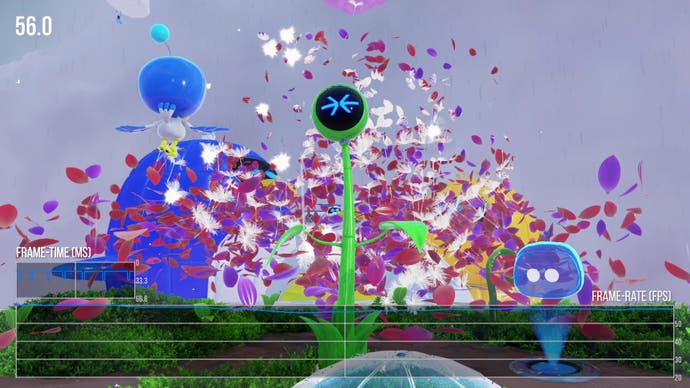
Then there's the fluid simulation: water, slime and other liquids are all fully simulated and react to forces exerted upon them. Nothing shows this off better than the aforementioned Japan stage where water realistically pools within the roof tiles, dribbling down to the floor below. This even factors into puzzles and obstacles - I love the way fluid interacts with Astro's movements, all of this is in pursuit of amping up that joy of movement.
Really, the whole game feels as if it were created to push as much 'stuff' as possible. Objects break, give and collect in huge numbers lending the game world a tremendous amount of life. As you rescue bots, for instance, they gather on the game's central planet and the engine has zero trouble displaying all of them at once. You can recruit them to help you out and it's a joy watching them all gather in huge numbers.
Of course, it's not like the visuals are also excellent. Astro Bot is a beautiful game featuring nicely crafted physically-based materials, especially metallic surfaces, and richly detailed levels. Environments stretch off into the distance and, by the time you reach the end of the stage, you can gaze back upon the path you just travelled. Bodies of water are another thing I absolutely love - the fake caustics and underwater atmospherics really lend it proper depth and the colours are just gorgeous.


This is definitely one of those cases where the art direction and careful design take point. There aren't really any fancy new visual techniques on display. Shadows are traditional cascaded shadow maps, for instance, while indirect illumination, such as light bounce from the sun, seems pre-calculated. Yet, it all gels into a cohesive whole. That said, I would have loved a better HDR implementation. Settings selection is minimal with just two HDR presets. I went with the brighter option and was generally happy.
Beyond that, the DualSense controller gets a significant work-out. I think many would agree that the haptics featured in Astro's Playroom are still among the best on the system - after all, it was made to show off the controller in the first place. Unsurprisingly, Astro Bot takes that even further. The sheer variation in terms of haptics feeding through the DualSense reminded me that, yes, this controller has some great features - it's just that nobody is really using it.
Every little footstep, rain droplet, object interaction and the like is represented via haptic feedback on the controller. Try running around an area with different surface materials and pay close attention to your controller - Astro's footsteps vary per surface. You can genuinely guess what sort of material Astro is standing on by haptics alone. Other features are also used: gyro, for instance, is used at various points with entire mechanics built specifically around it. Gyro is also used when controlling your flying DualSense at the beginning of each stage and even for aiming in some scenarios. Even the microphone is used, with certain sections asking you to blow into the mic in order to activate an object.
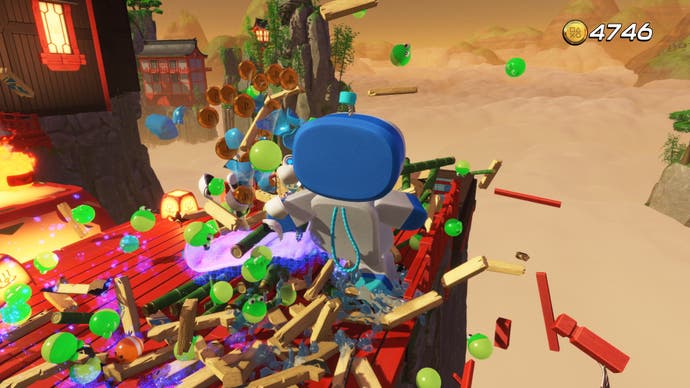
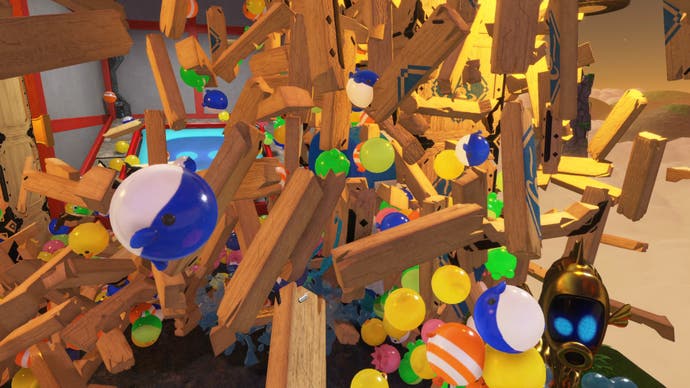
All of this accounts for just a portion of what makes Astro Bot so interesting and fun. The technology is important but the core design and what they do with it is what made me fall in love with the game. Firstly, when talking platform games, getting the basic move set and control nailed down is crucial. This has always been a strong point for Nintendo and Team Asobi as well have managed to pull it off. Astro's basic running and jumping have a satisfying feel and rhythm to them. Running, jumping and attacking enemies always feels great.
However, similar to Playroom, the team has built a huge range of power-ups and gadgets and then built entire level concepts around them seamlessly. Each of these are fun in their own right but the sheer variety and ease of use impressed me the most. Despite often radically altering your moveset, the game never resorts to tutorial text - just a small, animated pop-up indicating basic actions.
On top of all this, Astro Bot is basically a tribute to PlayStation's history and, in fact, in some ways, the medium as a whole. Sometimes there's just basic, fun references to classic characters, in-world jokes using PlayStation hardware including zip lines made from PS1 controller cords and the like. However, at other points, you take on the powers of key guest characters from PlayStation's past. There is, for instance, a God of War stage - I don't want to spoil the others, most of which I liked even more, but Kratos has appeared in marketing materials thus far so I felt like the best choice for showing an example.

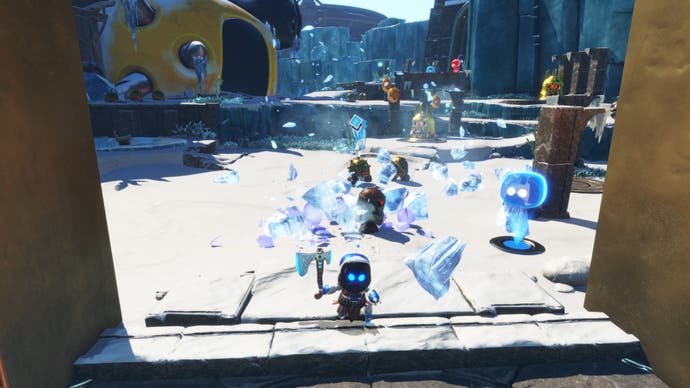
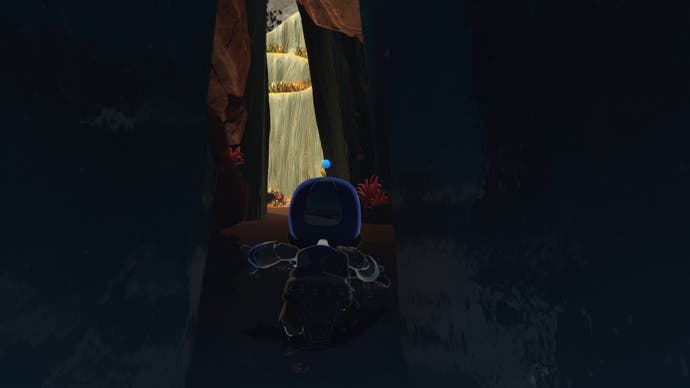

Essentially, here, key mechanics from the most recent God of War are put to use - specifically the axe where you can throw, freeze and retrieve the axe. This puts a completely different spin on platforming and combat. But they go even further to the point of referencing those narrow passages you often see in big AAA cinematic titles where the camera pulls in and your character slowly makes their way through it. It's extremely on the nose and I love it. All of this is just barely scratching the surface. The game is constantly toying with expectations, introducing ideas and concepts you might never have expected - it's overflowing with fun.
So, at this point, it's fair to say that Team Asobi nailed the core game feel, the level design and the visuals. It's a beautiful game that plays like a dream and offers things that manage to feel completely new and fun - and ultimately, as I think about my time playing Astro Bot, I can't help but feel great about it. Astro Bot is what video games are all about. It's pure joy and a reminder of what the first three generations of PlayStation embodied. It's a game that perfectly combines technology, design and creativity into a singular, ultra-polished whole without any filter whatsoever. This is about as perfectly executed as you can realistically expect these days and I urge you to play it.









